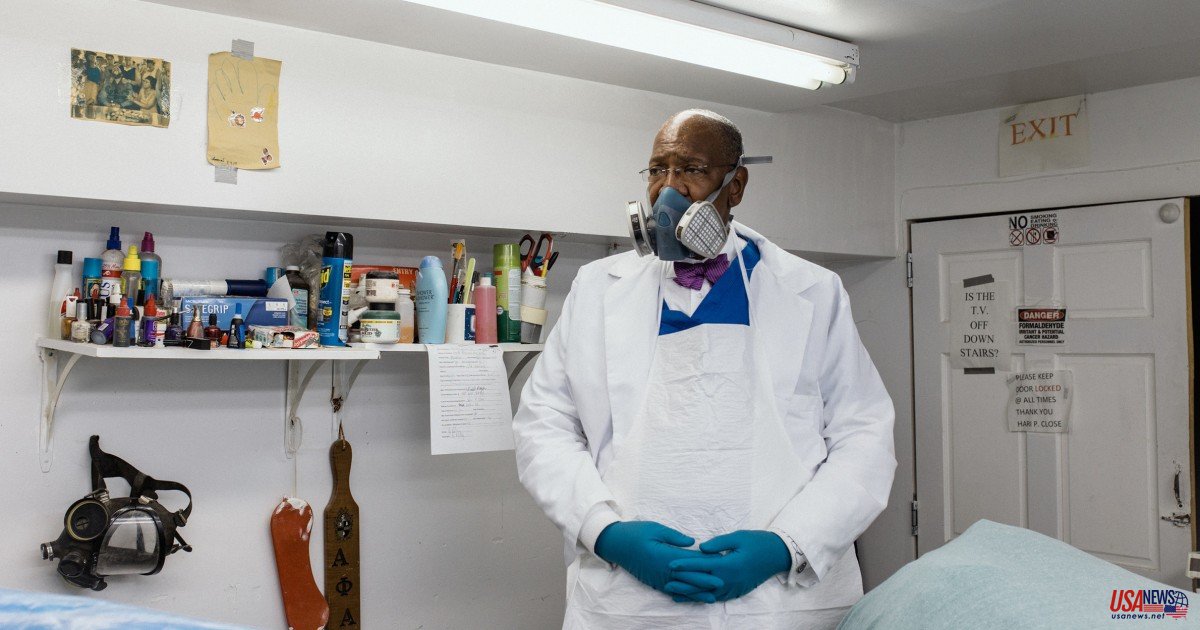Hari Close, a mortician who has embalmed more than 12,000 bodies in 30 years, is not surprised.
Close was speechless when he was given the task of preparing the body for a man who was shot in the head using an assault-style weapon.
Close spent 26 hours alone at his Baltimore funeral home over three days. He hoped that plaster, clay, and other materials would give closure to the man's family.
He couldn't do much. The man's top half was gone.
Imagine a full-face cut in half. Close described it as half an egg. Close said, "There wasn't anything there."
Close was able to see the destruction caused by high-powered firearms. Close saw the most recent intimate look at it. Close saw 35 victims in a Uvalde elementary school, Uvalde Elementary School, Texas; a Buffalo supermarket, New York; and a Tulsa Medical Center, Oklahoma.
Close, 61, is the president of National Funeral Directors & Morticians Association. It tears apart a body."
Close and other morticians have joined a nationwide appeal for federal legislators to make changes due to an increase in gun violence during the pandemic.
Close stated, "I would love for them to come to my funeral home and attempt to justify this type of death to families." They need to understand the realities of these guns.
Multiple morticians stated that an open-casket funeral can still be held if someone is shot in their head with a handgun. This is a crucial step in helping loved ones grieve, heal, and cope with sudden loss.
Monica Torres, a Phoenix cosmetic reconstructive specialist and embalmer, said that it's almost as if you don't believe they're gone. It makes it seem real when you can see the person.
Embalmers may use photographs of the deceased as reference to glue the cranium together.
"We do our best to use all of our skills. It's no different from what a surgeon would do. It's not post-mortem," stated Vernie Fountain, an embalmer, and a mortuary reconstructive expert in Springfield, Missouri.
You can also adjust the lighting or order a reverse casket, if the wound is not visible from the right side.
However, embalmers can only do so much if someone is hit in the head with an assault-style weapon.
Dominick Astorino is an embalmer and teaches mortuary science in Chicago and Detroit schools. "It greatly reduces the chances of success."
Astorino stated that he worked on numerous bodies of U.S. military personnel killed abroad by weapons of war and those of local residents who were gunned to death by assault-style weapons over the past decade.
He said, "The nature and extent of the injuries to the head seem explosive." It's extremely disturbing and unnecessary to see any human being in such a state.
Close stated that by the time morticians are able to receive shooting victims to prepare, most of the bodies have undergone autopsies. This is especially true if the coroners had to retrieve bullets for investigations.
Astorino stated that this adds to the embalmer's challenges and that each case is unique.
Astorino said that the victim's age could also affect restorations, as children younger than 6 years old have thinner skin and bones.
Morticians, along with trauma surgeons and coroners are the only people who must deal with such carnage over a long period of time.
Astorino stated, "It's a very closed-door type of thing." "And 99.9% of the U.S. populace, including our officials, don't see this kind of thing."
Close stated that funeral homes try to use the same embalmer on every body to ensure consistency. He estimated that each preparation takes between four and nine hours.
"We may spend hours reconstructing, but the end result will be a casket that the family will hold close to their hearts. "This is not him" or "This not her." He said, "That's still a difficult thing to swallow."
If there are enough bones to work with in extreme cases, embalmers might attempt to drill holes into the skull and wire it shut. Astorino & Torres said that such advanced techniques and others are rarely taught at the 60 American Board of Funeral Service Education accredited schools and programs.
They explained that cremation is becoming more popular than traditional burials in America. According to the National Funeral Directors Association of North America and the Cremation Association of North America, almost 2 million Americans, or more than 57% of all the deceased, will be cremated in 2021.
Torres, a 14-year veteran of the funeral industry, stated that embalming is not always necessary or requested in cases where there is no viewing.
Astorino was inspired by the decline in embalming and rising gun violence to include lessons in mass trauma reconstruction in his Detroit curriculum about three years ago.
Astorino stated that it can compound a family's grief when an open casket cannot be used or when loved ones are unable to see the deceased for the final time. He said, "It's impossible to describe what it's like." They've suffered this devastating, debilitating loss. It's heartbreaking to deny that.
Close agreed. He said that it was nerve-wracking for families to decide whether to keep a casket closed or open. The image of a loved person lying in a coffin often remains with them.
He said, "You're always going back to the initial viewing."
Doctors and surgeons who helped victims of the recent massacres have detailed in detail, in both emotional news conferences as well as congressional testimony, the horrific circumstances in which many of them died.
According to Dr. Ronald Stewart who treated victims of the Uvalde school shooting on May 24, high-velocity weapons can cause tissue injuries that are "extremely damaging". He said that most victims don't survive long enough for them to reach an emergency room.
Two children were "decapitated" in Uvalde and "pulverized, over and again, by the bullets shot at them," Dr. Roy Guerrero, Uvalde's only pediatrician, said. Guerrero explained to lawmakers that their flesh was so disfigured, and the only clue to their identities was the blood-spattered cartoon clothing still clinging on to them.
The injuries were severe even for those who survived. Similar incidents occurred in Buffalo where authorities claimed that a white gunman shot 10 people dead in a racist attack on Black people at Tops Friendly Market, May 14.
Zaire Goodman (20) survived the shooting but was left with a bullet wound to his neck, two to his back and one in his left leg. His mother Zeneta Everhart also testified before Congress that there were pieces of shrapnel in his body.
She told legislators that she could feel the bullet fragments in her son's back as she cleaned his wounds. "Now, I want you to imagine that exact scenario for one your children."
A bipartisan group made up of U.S. senators released a framework agreement for new gun legislation on Sunday. Proponents claim that if passed, it will be the first major federal gun legislation since nearly 30 years.
Although the initial package does not ban assault-style weapons and raise the legal age to buy them, these are two restrictions that many gun-safety advocates and Democratic legislators have advocated for. It does contain measures to improve background checks for gun buyers, and substantial resources to states to implement "red Flag" laws. These laws are designed to prevent people from purchasing or possessing firearms if they pose a threat to others or themselves.
After thousands of protestors marched to demand action at more than 450 rallies across the country, the tentative agreement was announced.
Close is encouraging more of his colleagues to join the fray, especially those from conservative states.
Close stated, "Funeral directors cannot stand still when they see the consequences of all this."













